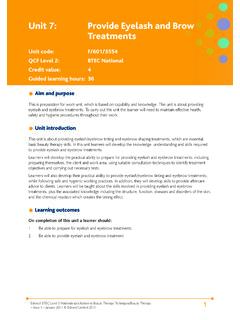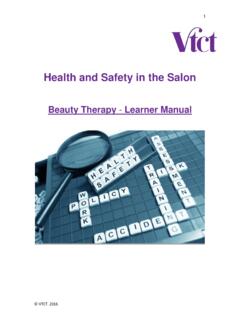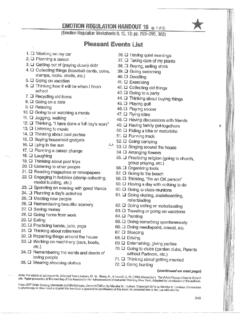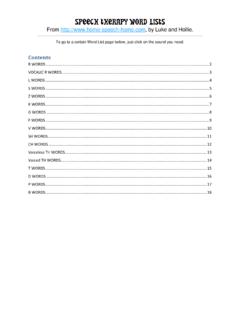Transcription of Unit 2: Client Care and Communication in Beauty- related ...
1 Edexcel BTEC Level 3 Nationals specification in beauty therapy Techniques/ beauty therapy Issue 1 January 2011 Edexcel Limited 20111 Unit 2: Client Care and Communication in Beauty- related IndustriesUnit code: T/601/4457 QCF Level 3: BTEC NationalsCredit value: 3 Guided learning hours: 28 Aim and purposeThis is a preparation for work unit, which is based on capability and knowledge. This unit is about Client care and Communication in Beauty- related industries. Learners will develop the ability to adapt their provision of Client care and their Communication skills to the needs of different clients, as well as how to manage Client introductionThis unit will allow learners to investigate Client care and Communication . The hair and beauty sector is a diverse area to work in and effective Communication skills are essential for business success. Learners will understand the methods and forms of Communication that can be used and how to adapt them to suit any given Client and situation.
2 They will investigate the importance of Client confidentiality and behaving in a professional manner as well as understand the techniques required to carry out consultations. This will enable them to identify Client requirements, manage Client expectations and provide suitable advice and recommendations to enhance the Client experience and increase business revenue. Learners will investigate the types of complaints clients make and understand how to resolve them. This unit will encourage learners to improve their working practices by gathering feedback and reviewing their own outcomesOn completion of this unit a learner should:1 Be able to communicate and behave in a professional manner when dealing with clients2 Be able to manage Client BTEC Level 3 Nationals specification in beauty therapy Techniques/ beauty therapy Issue 1 January 2011 Edexcel Limited 20112 Unit content1 Be able to communicate and behave in a professional manner when dealing with clientsProfessional behaviour: personal hygiene/appearance; behaviour eg polite, tactful, Client rapport; awareness of limits of own authority/responsibility; professionalismCommunication methods and techniques: verbal Communication (speaking, listening, open/closed questions); non-verbal Communication (body language); written Communication eg email, letters; methods of Communication (face to face, telephone, email/internet, reading).
3 Adapting methods of Communication to suit the Client and their needs eg nervous, non-nervous, new, regular, gender; advantages and disadvantages of different types of communicationConsultation techniques: questioning; visual; manual examination; reference to Client records; respecting clients personal space; use of support materials eg diagrams, pictures; identification of treatment objectives; contraindications to treatment; clear recommendations and importance (benefits to business, therapist, Client ); agree treatment plan2 Be able to manage Client expectationsMaintain Client confidentiality: comply with Data Protection Act 1998; measures used to maintain Client confidentiality (storage of paper based and electronic records and not sharing information)Retail sales techniques: identifying Client requirements; matching Client requirements to products and services; sales techniques (consultation, demonstration, recommendation, use of samples, closing the sale, overcoming concerns such as suitability and results); adapting sales techniques to suit individual Client needs (increase likelihood of sale, increase business revenue, Client retention) Client expectations: Client feedback; ways of improving Client experience eg level of care received, managing Client expectations so they are realistic; methods of improving working practices eg review performance, trainingClient complaints: types of complaint (poor quality service, financial disputes, unprofessional attitude).
4 Ways of resolving complaint eg referral, offer solution (money back, alternative treatment, free/discounted service), adhering to salon policy and current and relevant legislation eg Sale of Goods Act 1979, Consumer Protection Act 19873 Edexcel BTEC Level 3 Nationals specification in beauty therapy Techniques/ beauty therapy Issue 1 January 2011 Edexcel Limited 2011 Assessment and grading criteriaIn order to pass this unit, the evidence that the learner presents for assessment needs to demonstrate that they can meet all the learning outcomes for the unit. The assessment criteria for a pass grade describe the level of achievement required to pass this and grading criteriaTo achieve a pass grade the evidence must show that the learner is able to:To achieve a merit grade the evidence must show that, in addition to the pass criteria, the learner is able to:To achieve a distinction grade the evidence must show that, in addition to the pass and merit criteria, the learner is able to.
5 P1 behave in a professional manner within the workplace [TW3, TW4, SM5, SM7]P2 use effective Communication techniques when dealing with clients [IE1, TW2, SM7]M1 evaluate the Communication and consultation techniques used with different clientsD1 justify the suitability of Communication and consultation techniques used with different clientsP3 adapt methods of Communication to suit different situations and Client needs [TW3]P4 use effective consultation techniques to identify treatment objectives [IE1, IE2, IE5]M2 use effective consultation techniques to identify different treatment objectivesP5 provide clear recommendations to the Client [EP2, EP4, EP5]P6 assess the advantages and disadvantages of different types of Communication used with clients[IE3]P7 describe how to adapt methods of Communication to suit the Client and their needsP8 explain what is meant by the term professionalism within Beauty- related industriesP9 explain the importance of respecting a Client s personal space Edexcel BTEC Level 3 Nationals specification in beauty therapy Techniques/ beauty therapy Issue 1 January 2011 Edexcel Limited 20114 Assessment and grading criteriaTo achieve a pass grade the evidence must show that the learner is able to:To achieve a merit grade the evidence must show that, in addition to the pass criteria, the learner is able to:To achieve a distinction grade the evidence must show that, in addition to the pass and merit criteria, the learner is able to.
6 P10 describe how to use suitable consultation techniques to identify treatment objectivesP11 explain the importance of providing clear recommendations to the clientP12 maintain Client confidentiality in line with legislation[TW4]M3 recommend ways to manage Client expectations D2 justify ways of managing Client use retail sales techniques to meet Client requirements[TW2, TW3, EP4]P14 evaluate Client feedback[IE4, RL5]P15 evaluate measures used to maintain Client confidentialityP16 explain the importance of adapting retail sales techniques to meet Client requirementsP17 identify methods of improving own working practices[EP4]P18 describe how to resolve Client complaints.[IE1, SM6, EP1]M4 explain how to resolve Client : This summary references where applicable, in the square brackets, the elements of the personal, learning and thinking skills applicable in the pass criteria. It identifies opportunities for learners to demonstrate effective application of the referenced elements of the independent enquirersCT creative thinkersRL reflective learners TW team workersSM self-managersEP effective participators5 Edexcel BTEC Level 3 Nationals specification in beauty therapy Techniques/ beauty therapy Issue 1 January 2011 Edexcel Limited 2011 Essential guidance for tutorsDeliveryThis unit should be delivered in a Realistic Learning Environment (RLE), as detailed in Annexe F.
7 Clients can be friends and peers and does not mean treatment needs to be carried out on paying clients or within commercial timescales. Delivery of this unit should be as practical as possible to engage and motivate learners. Tutors are advised to use a variety of delivery methods to enable learners to develop the skills and techniques required when dealing with all aspects of Client care. This unit is suitable for co-delivery with any of the units which involve interacting with clients, for example, Unit 5: Provide Facial can use a variety of delivery methods when exploring the different forms of Communication and Client care, including observation of reception areas via webcams or inviting guest speakers from the beauty therapy industry to talk about the methods they use within their establishment to promote best practice in Communication with clients. Demonstration and comparisons of ineffective Communication can provide a basis for role play and group discussions, enabling learners to draw on their personal experiences.
8 This allows learners assess the impact of positive and negative from the Client s perspective. Tutors should set activities that develop learners experience, both as consumers and therapists, in identifying examples of good and bad Client wide range of possible Client scenarios provides scope for discussion, including how these scenarios need adapting for situation, Client and purpose. This could include, for example, interaction in a reception area, in a room during one-to-one treatment, on the telephone, or during a potential Client complaint. The variety of ways in which professional relationships are built on positive Communication is vital to the success of any business as these are transferable and valuable skills for career success. Learners should also be taught the advantages and disadvantages of different forms of Communication . Learners must be taught how to identify Client needs and expectations through the consultation process, the importance of body language and its role in effective Communication , building relationships and Client care, including the importance of respecting clients personal space.
9 Tutors should explore with learners the reasons for providing advice to and recommendations, for clients. Learners should be taught the techniques used to identify retail opportunities and should be able to practise using these techniques. They should understand that poor Communication and consultation adversely affects the success of a business. Mock-ups of retail displays where learners can practise their skills in recommending products and services are invaluable. Organised visits to department stores to observe professional retail skills in action on cosmetic counters are beneficial. Often, clients can have unrealistic expectations of beauty products and/or treatments and their effects. Learners need to be able to inform clients of features and benefits of products and services without misleading are expected to be able to demonstrate a professional approach throughout this unit in terms of behaviour, maintaining Client confidentiality, using retail sales techniques, managing Client expectations, dealing with Client complaints and adhering to current, relevant must understand that when complaints have been made, they need to act on them in the right manner to retain the Client and maintain business reputation.
10 Role play of clients complaining will develop learners skills in managing this very difficult at how to improve working practices presents an opportunity for learners to gather and evaluate feedback on their own performance and identify areas for personal development and improvement, these are skills that will serve them well when they start work in the BTEC Level 3 Nationals specification in beauty therapy Techniques/ beauty therapy Issue 1 January 2011 Edexcel Limited 20116 Outline learning planThe outline learning plan has been included in this unit as guidance and can be used in conjunction with the programme of suggested outline learning plan demonstrates one way in planning the delivery and assessment of this unit. Topic and suggested assignments/activities and/assessmentTutor introduction to the unitAssignment 1: Client Consultation (P1, P2, P3, P4, P5, P12, P13, M2, M3). Tutor introduction to assignment brief. Assignment 2: Communicating with Clients (P6, P7, P8, P9, P10, P11, P16, P18, M4, D2).
















